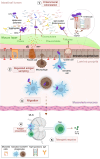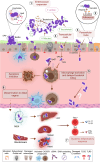Enterococcal-host interactions in the gastrointestinal tract and beyond
- PMID: 39391373
- PMCID: PMC11466040
- DOI: 10.1093/femsmc/xtae027
Enterococcal-host interactions in the gastrointestinal tract and beyond
Abstract
The gastrointestinal tract (GIT) is typically considered the natural niche of enterococci. However, these bacteria also inhabit extraintestinal tissues, where they can disrupt organ physiology and cause life-threatening infections. Here, we discuss how enterococci, primarily Enterococcus faecalis, interact with the intestine and other host anatomical locations such as the oral cavity, heart, liver, kidney, and vaginal tract. The metabolic flexibility of these bacteria allows them to quickly adapt to new environments, promoting their persistence in diverse tissues. In transitioning from commensals to pathogens, enterococci must overcome harsh conditions such as nutrient competition, exposure to antimicrobials, and immune pressure. Therefore, enterococci have evolved multiple mechanisms to adhere, colonize, persist, and endure these challenges in the host. This review provides a comprehensive overview of how enterococci interact with diverse host cells and tissues across multiple organ systems, highlighting the key molecular pathways that mediate enterococcal adaptation, persistence, and pathogenic behavior.
Keywords: commensal to pathogen transition; dysbiosis; enterococcal-host interactions; enterococci; gastrointestinal tract; inter-organ dissemination.
© The Author(s) 2024. Published by Oxford University Press on behalf of FEMS.
Conflict of interest statement
None declared.
Figures




Similar articles
-
Bacteriocin production augments niche competition by enterococci in the mammalian gastrointestinal tract.Nature. 2015 Oct 29;526(7575):719-22. doi: 10.1038/nature15524. Epub 2015 Oct 19. Nature. 2015. PMID: 26479034 Free PMC article.
-
Colonization of the mammalian intestinal tract by enterococci.Curr Opin Microbiol. 2019 Feb;47:26-31. doi: 10.1016/j.mib.2018.10.005. Epub 2018 Nov 13. Curr Opin Microbiol. 2019. PMID: 30439685 Free PMC article. Review.
-
Remodeling of the Enterococcal Cell Envelope during Surface Penetration Promotes Intrinsic Resistance to Stress.mBio. 2022 Dec 20;13(6):e0229422. doi: 10.1128/mbio.02294-22. Epub 2022 Nov 10. mBio. 2022. PMID: 36354750 Free PMC article.
-
Enterococci and Their Interactions with the Intestinal Microbiome.Microbiol Spectr. 2014 Nov;5(6):10.1128/microbiolspec.bad-0014-2016. doi: 10.1128/microbiolspec.BAD-0014-2016. Microbiol Spectr. 2014. PMID: 29125098 Free PMC article.
-
The Physiology and Metabolism of Enterococci.2014 Feb 15. In: Gilmore MS, Clewell DB, Ike Y, Shankar N, editors. Enterococci: From Commensals to Leading Causes of Drug Resistant Infection [Internet]. Boston: Massachusetts Eye and Ear Infirmary; 2014–. 2014 Feb 15. In: Gilmore MS, Clewell DB, Ike Y, Shankar N, editors. Enterococci: From Commensals to Leading Causes of Drug Resistant Infection [Internet]. Boston: Massachusetts Eye and Ear Infirmary; 2014–. PMID: 24649507 Free Books & Documents. Review.
Cited by
-
A new approach to osteoarthritis: gut microbiota.Rev Assoc Med Bras (1992). 2025 May 2;71(3):e20241528. doi: 10.1590/1806-9282.20241528. eCollection 2025. Rev Assoc Med Bras (1992). 2025. PMID: 40332266 Free PMC article.
-
Cross-organ metabolite production and consumption in healthy and atherogenic conditions.Cell. 2025 Aug 7;188(16):4441-4455.e16. doi: 10.1016/j.cell.2025.05.001. Epub 2025 May 27. Cell. 2025. PMID: 40436017
References
-
- Agudelo Higuita NI, Huycke MM. Enterococcal disease, epidemiology, and implications for treatment. In: Gilmore MS, Clewell DB, Ike Y, Shankar N (eds), Enterococci: From Commensals to Leading Causes of Drug Resistant Infection. Boston: Massachusetts Eye and Ear Infirmary, 2014.
-
- Akbari Aghdam M, Soroush Barhaghi MH, Aghazadeh M et al. Virulence genes in biofilm producer Enterococcus faecalis isolates from root canal infections. Cell Mol Biol (Noisy-le-grand). 2017;63:55–59. - PubMed
-
- Al-Ahmad A, Muller N, Wiedmann-Al-Ahmad M et al. Endodontic and salivary isolates of Enterococcus faecalis integrate into biofilm from human salivary bacteria cultivated in vitro. J Endod. 2009;35:986–91. - PubMed
Publication types
LinkOut - more resources
Full Text Sources
